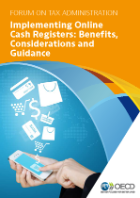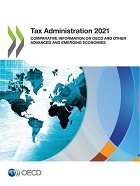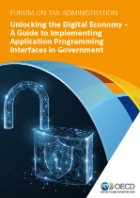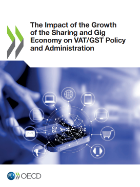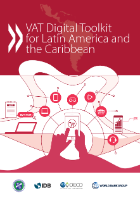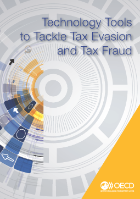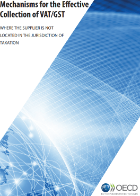Value added tax
Value added taxes (VAT) account for around 20% of total tax revenue (including social security contributions) collected across OECD countries and they often represent 30% or more of total taxes in non-OECD countries.
Just like any other type of tax, also VAT is vulnerable to fraud and non-compliance. While organised VAT fraud, both domestic and in cross-border trade, has often been causing significant revenue losses for VAT regimes worldwide, there is also an element of non-compliance caused by taxpayers that may be unaware of their VAT obligations or that may lack to capacity to comply. This is exacerbated by the increasing digitalisation of the economy, which has fundamentally changed the nature of how consumers and businesses interact, with continuously growing volumes of services, digital products and goods being purchased online from vendors, including e-commerce marketplaces, which are often located outside consumers’ home jurisdiction.
Administrations and policy makers are increasingly looking at the opportunities offered by digitalisation to help reduce their VAT gap, including by:
- Increasing electronic recording and/or reporting requirements on transactions for example through requirements to use e-invoices, to store transaction information on approved devices, or to provide tax administrations access to invoice information electronically.
- Developing new approaches to VAT collection on online sales,in particularby imposing collection obligations on digital platform operators for the VAT on e-commerce sales that are carried out on their platforms.
- Enhancing risk assessment through the incorporation of a greater range of data sources and the use of new analytics tools including, in some cases, the use of artificial intelligence (AI).
- Improving online services to make it easier for taxpayers to understand their tax obligations, to interact with the tax administration and to report their activities that are subject to VAT. This can include providing third parties with software that allows them to embed tax services and processes in the natural systems used by businesses.
Increasing reporting requirements on transactions
In their efforts to address non-reporting and underreporting of sales, tax administrations are introducing technology solutions that allow timely and uncompromised access to transaction-level data. Advances in digital technology have provided further options to tax administrations to access information electronically, including access to real-time information in some cases. Among the available technology solutions to enhance VAT reporting, the following two have been adopted by a growing number of jurisdictions:
- Electronic cash registers: To address under-reporting in the retail sector, many jurisdictions have introduced legal frameworks requiring retail businesses to use some form of secure electronic cash register to generate and preserve sales data for tax compliance purposes. In some jurisdictions there is a requirement for electronic cash registers, so called online cash registers, to transmit the information in encrypted form to the tax administration in real-time or close to real-time. More on this, including 4 case studies on the implementation of online cash register systems, can be found in the OECD report Implementing Online Cash Registers: Benefits, Considerations and Guidance.
- Electronic invoicing systems: Digitalisation of the exchange of invoices can offer opportunities to both businesses and tax administrations including the enhancement of the reporting process and VAT payment quality and timelines, as well as error reduction and reduced burdens. A growing number of tax administrations is requiring businesses to send the electronic invoice information in a specified format to the tax administration either before the transaction is completed or shortly afterwards. Some administrations also require the invoice information to be submitted to the tax administration for approval prior to the conclusion of the transaction.
While these systems, if well designed and supported by proper policy design and taxpayer services, can help reduce non-compliance by making it easier to comply and harder not to comply, they can also enhance tax administrations’ risk assessment capacity (see further below) and facilitate the introduction of new services such as the prefilling of VAT tax returns. This could significantly reduce the compliance burden of taxpayers and, by reducing the need for manual data entry while filing VAT returns, reduce data entry errors.
Data collection and prefilling of VAT returns
Note: To understand fully the information included in this map, users are advised to look at the source data tables and the original survey question as some of the self-reported data may not give the full picture and may need to be looked at in the wider context of the survey.
Developing new approaches to VAT collection on online sales
The increasing volume of online sales of goods has created increasingly important challenges for collecting the VAT, particularly on imports of low-value goods. To address these issues, a growing number of jurisdictions have successfully replaced the traditional customs process for collecting the VAT on low-value imported goods by a requirement for online vendors and digital platforms to collect the VAT on these goods at the point of sale. This as well as other roles for digital platforms to assist with the collection of VAT on online sales, is discussed in the OECD report The Role of Digital Platforms in the Collection of VAT/GST on Online Sales.
Enhancing risk assessment
Data that tax administrations receive, for example from electronic cash registers or e-invoicing systems, can be used to review taxpayer reported information through tax audits, automated electronic checks, validations (including customer validations) and the matching of taxpayer information. The undertaking and visibility of these and other compliance actions can play a significant role in supporting compliance, including through their impacts on perceptions of fairness in the tax system.
The increased availability of data also allows for a sharpened targeting of risks and as well as the analysis of emerging trends and, through the application of data science and advanced analytics techniques, can help to uncover patterns which may indicate non-compliance. For example, among other things, it is possible for algorithms to automatically compare the sales of businesses in the same sector and region and, where these fall outside of certain ranges, to trigger further investigations.
Administrations that use AI in VAT risk assessment processes
Note: To understand fully the information included in this map, users are advised to look at the source data tables and the original survey question as some of the self-reported data may not give the full picture and may need to be looked at in the wider context of the survey.
Source: Table TRM3
Click on Data Management for more information on how administrations manage their data, including data collection, data sharing and data analytics; or Tax Rule Management for how administrations use technology for tax rule management.
Improving online services
On a daily basis, tax administrations are communicating and interacting with businesses. The vast majority of those firms are small and medium-sized enterprises and, for many of those, dealing with tax obligations is a burdensome activity that often comes with uncertainty. To build a voluntary compliance culture among businesses it is important that tax administrations provide a wide range of effective and easy to use taxpayer communication and service channels, both on a reactive and proactive basis, as well as programmes to assist and educate business owners with meeting their tax obligations.
As regards communication, often these have been delivered on a one-to-many basis, such as the provision of guidance or reminders as well as calculation and reporting tools. However, the use of innovative tools allows communications to become more personalised to the business owners’ individual circumstances, to be delivered via an increasing range of communication channels and to facilitate the drive towards self-service.
With an increase in taxpayer expectations, the self-service offering from tax administrations is growing. Common examples of this include the ability to register, file and pay online, along with a range of interactive tools. This is leading to efficiency gains in tax administrations, as well as being able to provide a more 24/7-style service to taxpayers.
Value added tax: Online services provided by tax administrations
Note: To understand fully the information included in this map, users are advised to look at the source data tables and the original survey question as some of the self-reported data may not give the full picture and may need to be looked at in the wider context of the survey.
Source: Table TT3
While tax administrations are providing services through their own websites, a large number of administrations are also creating application programming interfaces (APIs) which allow connectivity between systems, people and things without providing direct access to tax administration internal systems. As well as using them in their own applications, many tax administrations are also making those APIs available to third party software developers allowing them to develop new applications and, in some cases, to embed tax services and processes in the natural systems used by businesses. The use of APIs in this way can help to improve tax compliance while also reducing administrative burdens on taxpayers. The map below shows for which type of VAT interactions tax administrations have published APIs. For more about the provision of online services by tax administrations, the (co-)creation of software packages or the development of application programming interfaces (APIs) click here: Taxpayer Touchpoints
Value added tax: Interactions for which administrations have published APIs
Note: To understand fully the information included in this map, users are advised to look at the source data tables and the original survey question as some of the self-reported data may not give the full picture and may need to be looked at in the wider context of the survey.
Source: Table TT10
Further information
|
Technology Tools to Tackle Tax Evasion and Tax Fraud
|
Mechanisms for the Effective Collection of VAT/GST |
Related Documents


